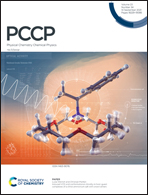Fluorescence band exchange narrowing in a series of squaraine oligomers: energetic vs. structural disorder†
Abstract
The influence of oligosquaraine chain length on the energies and shape of absorption and emission bands and the exciton coherence length is studied in CHCl3 where the oligomers adopt a random coil structure. From the observed fluorescence band narrowing an effective coherence length of Ncoh = 2.5 was estimated for the nonamer. Applying a theoretical Frenkel exciton model the absorption and emission spectra were simulated which confirmed the experimental results. From the relative amplitude of the 00 peak to the vibronic shoulder the coherence length was estimated which yields a somewhat higher saturation value of Ncoh ≈ 3 for the nonamer, which is in very good agreement with the theoretical amplitude ratio. The coherence length is much smaller than the geometrical length because the electronic delocalisation is reduced by structural disorder. Taking into account the energetic (diagonal) and structural (off-diagonal) disorder we observed a different influence on the absorption and fluorescence spectra. For the emission spectra, exciton delocalisation leads to a narrowing of the band caused by averaging over energetic disorder, but for the absorption band the spectra are broadened by excitonic splitting and structural disorder.

- This article is part of the themed collection: 2021 PCCP HOT Articles


 Please wait while we load your content...
Please wait while we load your content...